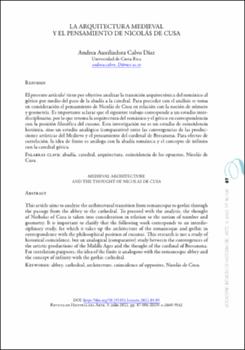La arquitectura medieval y el pensamiento de Nicolás de Cusa
Date
2022Abstract
El presente artículo tiene por objetivo analizar la transición arquitectónica del románico al
gótico por medio del paso de la abadía a la catedral. Para proceder con el análisis se toma
en consideración el pensamiento de Nicolás de Cusa en relación con la noción de número
y geometría. Es importante aclarar que el siguiente trabajo corresponde a un estudio inter-
disciplinario, por lo que retoma la arquitectura del románico y el gótico en correspondencia
con la posición filosófica del cusano. Esta investigación no es un estudio de coincidencia
histórica, sino un estudio analógico (comparativo) entre las convergencias de las producciones artísticas del Medievo y el pensamiento del cardenal de Bresanona. Para efectos de
correlación, la idea de finito es análoga con la abadía románica y el concepto de infinito
con la catedral gótica. This article aims to analyze the architectural transition from romanesque to gothic through
the passage from the abbey to the cathedral. To proceed with the analysis, the thought
of Nicholas of Cusa is taken into consideration in relation to the notion of number and
geometry. It is important to clarify that the following work corresponds to an interdis-
ciplinary study, for which it takes up the architecture of the romanesque and gothic in
correspondence with the philosophical position of cusanus. This research is not a study of
historical coincidence, but an analogical (comparative) study between the convergences of
the artistic productions of the Middle Ages and the thought of the cardinal of Bresanona.
For correlation purposes, the idea of the finite is analogous with the romanesque abbey and
the concept of infinity with the gothic cathedral.





